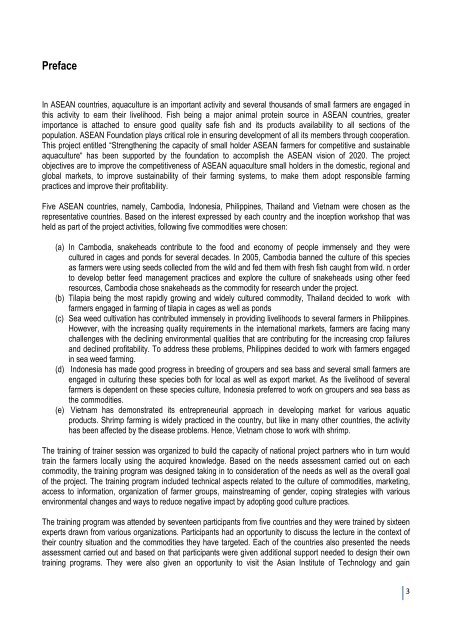Training of Trainers - Library - Network of Aquaculture Centres in ...
Training of Trainers - Library - Network of Aquaculture Centres in ...
Training of Trainers - Library - Network of Aquaculture Centres in ...
- No tags were found...
Create successful ePaper yourself
Turn your PDF publications into a flip-book with our unique Google optimized e-Paper software.
PrefaceIn ASEAN countries, aquaculture is an important activity and several thousands <strong>of</strong> small farmers are engaged <strong>in</strong>this activity to earn their livelihood. Fish be<strong>in</strong>g a major animal prote<strong>in</strong> source <strong>in</strong> ASEAN countries, greaterimportance is attached to ensure good quality safe fish and its products availability to all sections <strong>of</strong> thepopulation. ASEAN Foundation plays critical role <strong>in</strong> ensur<strong>in</strong>g development <strong>of</strong> all its members through cooperation.This project entitled “Strengthen<strong>in</strong>g the capacity <strong>of</strong> small holder ASEAN farmers for competitive and susta<strong>in</strong>ableaquaculture“ has been supported by the foundation to accomplish the ASEAN vision <strong>of</strong> 2020. The projectobjectives are to improve the competitiveness <strong>of</strong> ASEAN aquaculture small holders <strong>in</strong> the domestic, regional andglobal markets, to improve susta<strong>in</strong>ability <strong>of</strong> their farm<strong>in</strong>g systems, to make them adopt responsible farm<strong>in</strong>gpractices and improve their pr<strong>of</strong>itability.Five ASEAN countries, namely, Cambodia, Indonesia, Philipp<strong>in</strong>es, Thailand and Vietnam were chosen as therepresentative countries. Based on the <strong>in</strong>terest expressed by each country and the <strong>in</strong>ception workshop that washeld as part <strong>of</strong> the project activities, follow<strong>in</strong>g five commodities were chosen:(a) In Cambodia, snakeheads contribute to the food and economy <strong>of</strong> people immensely and they werecultured <strong>in</strong> cages and ponds for several decades. In 2005, Cambodia banned the culture <strong>of</strong> this speciesas farmers were us<strong>in</strong>g seeds collected from the wild and fed them with fresh fish caught from wild. n orderto develop better feed management practices and explore the culture <strong>of</strong> snakeheads us<strong>in</strong>g other feedresources, Cambodia chose snakeheads as the commodity for research under the project.(b) Tilapia be<strong>in</strong>g the most rapidly grow<strong>in</strong>g and widely cultured commodity, Thailand decided to work withfarmers engaged <strong>in</strong> farm<strong>in</strong>g <strong>of</strong> tilapia <strong>in</strong> cages as well as ponds(c) Sea weed cultivation has contributed immensely <strong>in</strong> provid<strong>in</strong>g livelihoods to several farmers <strong>in</strong> Philipp<strong>in</strong>es.However, with the <strong>in</strong>creas<strong>in</strong>g quality requirements <strong>in</strong> the <strong>in</strong>ternational markets, farmers are fac<strong>in</strong>g manychallenges with the decl<strong>in</strong><strong>in</strong>g environmental qualities that are contribut<strong>in</strong>g for the <strong>in</strong>creas<strong>in</strong>g crop failuresand decl<strong>in</strong>ed pr<strong>of</strong>itability. To address these problems, Philipp<strong>in</strong>es decided to work with farmers engaged<strong>in</strong> sea weed farm<strong>in</strong>g.(d) Indonesia has made good progress <strong>in</strong> breed<strong>in</strong>g <strong>of</strong> groupers and sea bass and several small farmers areengaged <strong>in</strong> cultur<strong>in</strong>g these species both for local as well as export market. As the livelihood <strong>of</strong> severalfarmers is dependent on these species culture, Indonesia preferred to work on groupers and sea bass asthe commodities.(e) Vietnam has demonstrated its entrepreneurial approach <strong>in</strong> develop<strong>in</strong>g market for various aquaticproducts. Shrimp farm<strong>in</strong>g is widely practiced <strong>in</strong> the country, but like <strong>in</strong> many other countries, the activityhas been affected by the disease problems. Hence, Vietnam chose to work with shrimp.The tra<strong>in</strong><strong>in</strong>g <strong>of</strong> tra<strong>in</strong>er session was organized to build the capacity <strong>of</strong> national project partners who <strong>in</strong> turn wouldtra<strong>in</strong> the farmers locally us<strong>in</strong>g the acquired knowledge. Based on the needs assessment carried out on eachcommodity, the tra<strong>in</strong><strong>in</strong>g program was designed tak<strong>in</strong>g <strong>in</strong> to consideration <strong>of</strong> the needs as well as the overall goal<strong>of</strong> the project. The tra<strong>in</strong><strong>in</strong>g program <strong>in</strong>cluded technical aspects related to the culture <strong>of</strong> commodities, market<strong>in</strong>g,access to <strong>in</strong>formation, organization <strong>of</strong> farmer groups, ma<strong>in</strong>stream<strong>in</strong>g <strong>of</strong> gender, cop<strong>in</strong>g strategies with variousenvironmental changes and ways to reduce negative impact by adopt<strong>in</strong>g good culture practices.The tra<strong>in</strong><strong>in</strong>g program was attended by seventeen participants from five countries and they were tra<strong>in</strong>ed by sixteenexperts drawn from various organizations. Participants had an opportunity to discuss the lecture <strong>in</strong> the context <strong>of</strong>their country situation and the commodities they have targeted. Each <strong>of</strong> the countries also presented the needsassessment carried out and based on that participants were given additional support needed to design their owntra<strong>in</strong><strong>in</strong>g programs. They were also given an opportunity to visit the Asian Institute <strong>of</strong> Technology and ga<strong>in</strong>3
















